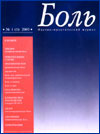Helping the helpers in pain medicine
Sir Michael Bond, Glasgow, Scotland
Coping is a cognitive and behavioural mechanism or set of strategies which all of us use, consciously and unconsciously, to deal with the range of problems we encounter in everyday life. The strategies are regarded as active when we make deliberate attempts to function as normally as possible despite our problems, and to be passive when we withdraw or rely upon others to solve our problems for us. Coping as a pain clinician whether doctor, nurse, psychologist, physical therapist or other professional, involves the use of a range of strategies as a response to the demands made by patients, their relatives and the administrative system in which they work.
Fortunately, we are seldom if ever left to cope without any preparation because we develop around us as we progress through our professional lives, a combination of protective mechanisms and structures. They come through our training and education with the confidence they give to us when dealing with complex clinical problems : we leam our trades, we learn how to relate to our colleagues and we learn how to find help when we need it. The structures within which we work should give us the support which we need, for example adequate physical facilities in hospitals and clinics, the equipment and personnel we need to conduct our work efficiently and systems that permit us to provide a full range of care to all those who need it. Although training and education are regulated within the various professional groups of those who care for pain, the necessary training is not always available. The International Association for Pain (IASP) has, for example, produced a range of curricula for use by various professional groups - doctors, dentists, nurses, psychologists and others but there is evidence that often they are not used. In 1990 an IASP Task Force developed the necessary requirements for the various types of pain treatment facility - a generic term used to describe all forms of treatment facilities (multi-disciplinary pain centres, multi- disciplinary pain clinics and modality-orientated clinics). The IASP recommendations are known throughout the world but all too often at the national and local level in different countries there are insufficient resources available to establish such facilities in full.
In the United Kingdom, the government published a report entitled "Services for Pain Patients with Pain" in April this year. It reveals a significant variation in the provisions made for pain management across Britain. In general terms, the facilities for the management of acute pain, usually post operative pain, and for palliative care units are significantly better than those for Accident and Emergency departments and Chronic Pain Management centres. The report shows that in poorly resourced facilities, clinicians have difficulty in meeting the demand for pain relief because they arc overwhelmed by the numbers of patients, they lack the full range of professional skills needed and the necessary equipment required. They find themselves in frequent confrontations with their administrators when they seek resources. The report concluded that the problems faced by pain clinicians have to be resolved locally. A quote from the President of the Australian Pain Society summarises the position in the United Kingdom as well as in Australia and other countries.
He wrote "If we want to change any of the systems that affect the way we deliver care to our patients, we will have to lobby for that change ourselves, no one else will do it for us. We must make use of our strengths."
We are able to define therefore two areas of potential stress to carers, first, inadequate education and training and second, the lack of the facilities necessary for the treatment of those who require services. British and Australian experiences which undoubtedly are those of colleagues in other countries, reflect the reality of the situation and the fact that we do not live in an ideal world.
We return to the question of coping at a personal level with the various problems faced by the inadequacies of pain management systems and the additional problem of difficulties posed for us by patients and their relatives. Any failure to cope is reflected usually in terms of anxiety, emotional tension, increased anger and in some depression. In behavioural terms, individuals may withdraw from contact from others or absent themselves from work ; often with stress induced illnesses. Tensions rise between individuals working within the clinic setting and resignations and early retirements happen at times.
Having described the background against which many pain professionals have to work and briefly the emotional problems that may develop, a question of how to minimise stress arises. Those involved need to give consideration to the question of leadership, communication within and between the professional groups involved, adequate staff education and training and means of detecting and dealing with colleagues who develop signs of stress. Those topics will be addressed in full during this plenary lecture.
Reference
Services for Patients with Pain, Report of a CSAG Committee, Department of Health. London. April 2000.
Pain in Europe III. EFIC 2000, Nice, France, September 26-29, 2000. Abstracts book, p. 64 - 65.






